There’s nothing quite like this roasted chicken recipe. It gives you crispy skin bathed in butter and meat softly scented with lemon, garlic, and rosemary. There are unctuous potatoes and carrots that cook in chicken jus. It perfumes your entire household. And you can transform a single bird into meals that last for days on end. It truly is perfection.
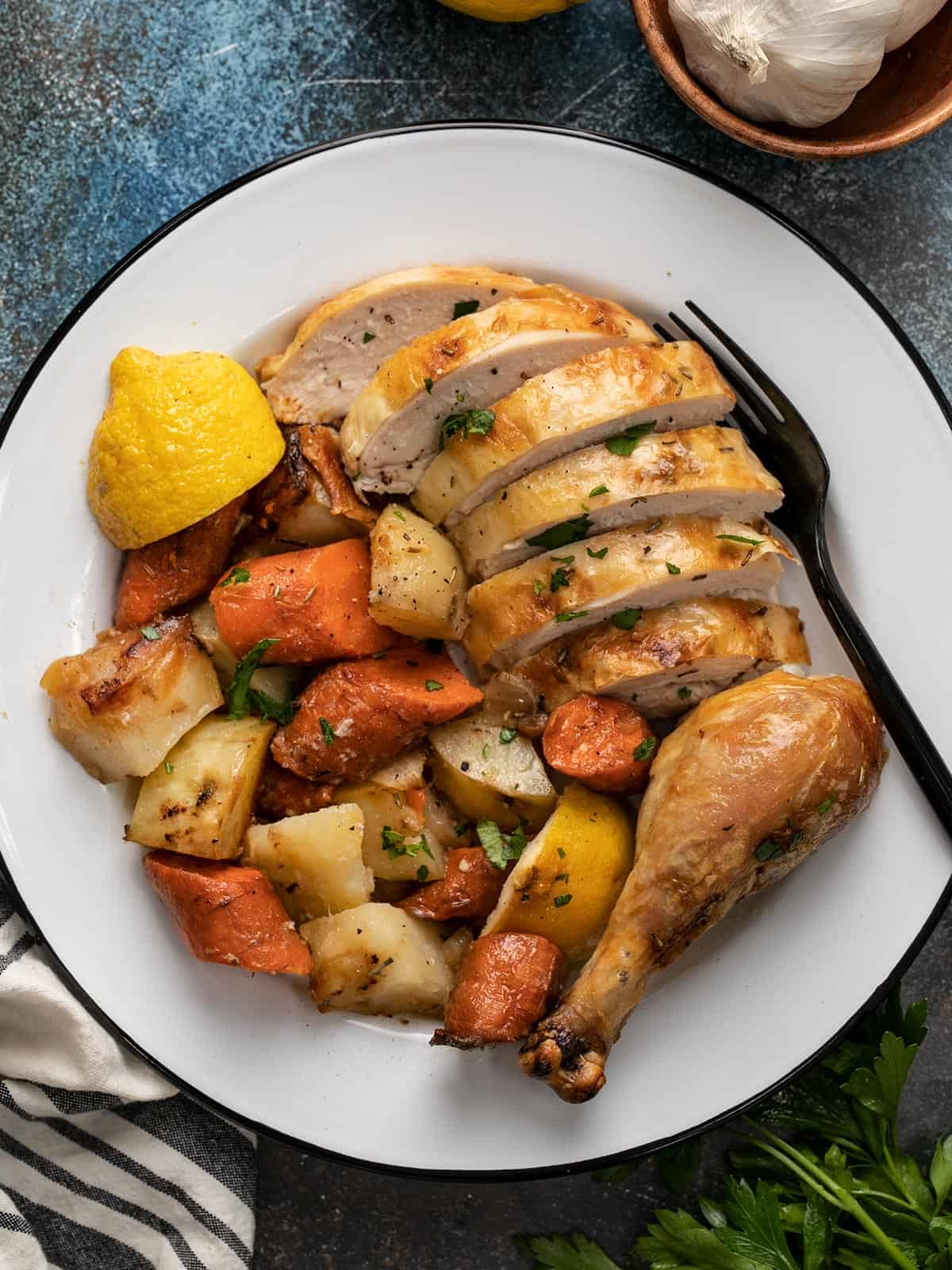
All recipes are rigorously tested in our Nashville Test Kitchen to ensure they are easy, affordable, and delicious.
How To Perfectly Roast Chicken
For the uninitiated, roasting a whole chicken can be intimidating. But it’s easier than you think. You just need to know a few tricks, and luckily you’ve got a friend that has them all up her sleeve. Ahem. It all comes down to is drying your chicken, using salt correctly, introducing fat to keep the breast meat moist, and using the cavity as a vehicle for flavor.
To make the best roasted chicken, use these four tricks:
- Dry your chicken well for extra crispy skin
- Use a dry brine to keep meat tender and infuse flavor
- Coat with herb butter for a deliciously golden brown crispy skin
- Stuff the cavity with aromatics to make every bite flavorful
Why Should I Dry Chicken?
The first trick to perfectly roasting a chicken is thoroughly drying your bird. I know it sounds counterintuitive. Why would you take juices off a chicken you want to be juicy? Because it gives you the crispiest skin ever. It’s so crucial that some chefs go as far as drying their chicken with a hair dryer. You don’t have to go that far, but don’t skip this step. It sets you up beautifully for a dry brine.
What Is A Dry Brine?
Dry brining is the act of salting chicken (or any other meat) and letting it sit uncovered while the salt draws out the juices. The chicken then reabsorbs the now salted juices, which tenderize the meat and add deep flavors all the way to the bone. This is far superior to just salting the skin on the outside, which leaves you with a bland bird. You can dry brine for as little as an hour, but if you want real magic, dry brine your chicken overnight. Leave it uncovered in your fridge, on the bottom shelf, for at least 8 hours. Then it’s ready for a butter bath.
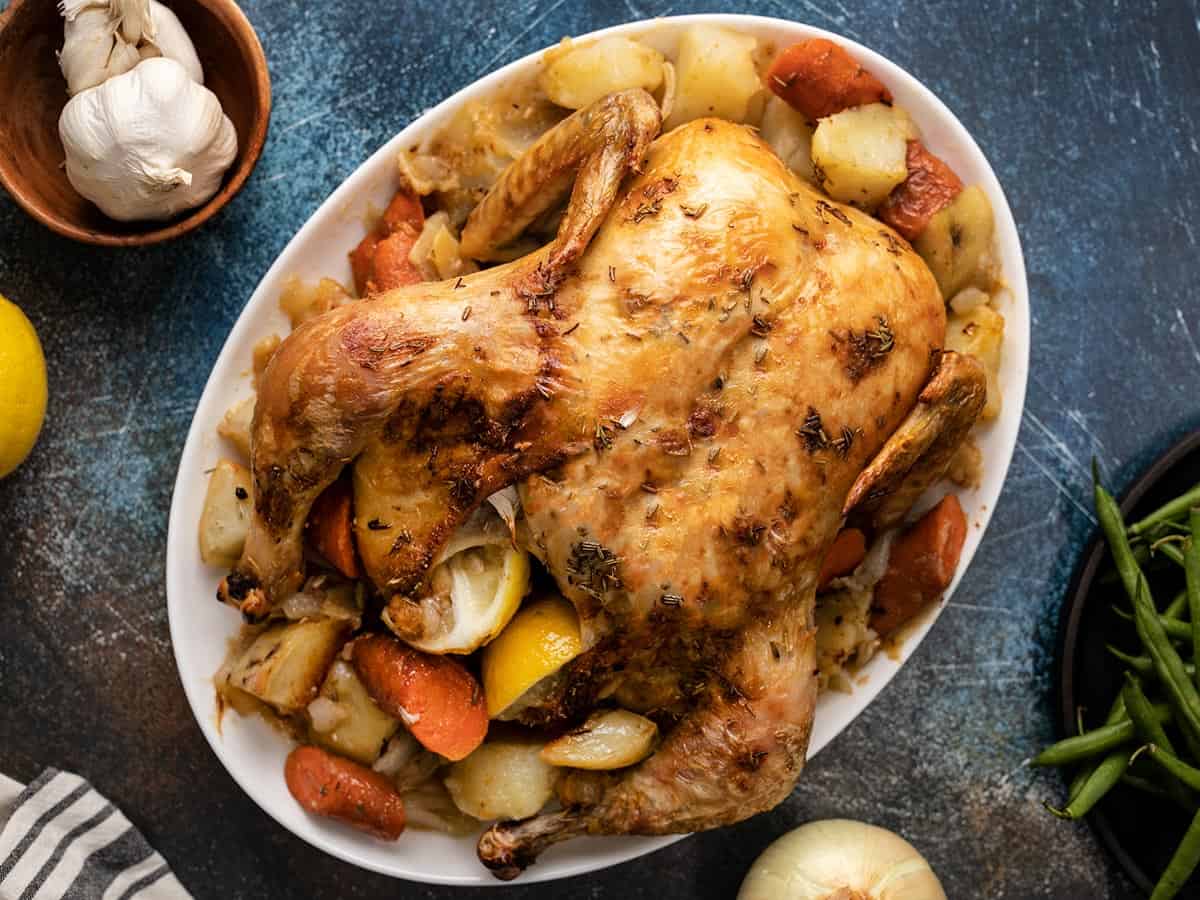
Why Do People Put Butter On Their Chicken?
You add fat to the chicken breast to keep it moist and then you spread it on the skin to crisp it. The best and tastiest way to do that is to rub your chicken down with softened butter. (Unless you save your bacon fat, in which case, you should definitely use that!). As the butter melts, it bastes the notoriously dry breast meat, which keeps it juicy while adding a huge wallop of flavor. It will also give you deeply golden, crispy skin. Now all you have to do is to level up your flavor game by stuffing the chicken cavity with aromatics.
Why Should I Stuff Chicken?
Leaving the chicken’s cavity empty is a missed opportunity to add flavor. Stuff the cavity with aromatics, like garlic and lemon. If you have fresh rosemary, put a sprig in there as well. (If you don’t, that’s OK. You can add dried rosemary to your butter.) As the chicken cooks, the garlic, lemon, and rosemary release their essences and perfume your entire bird, from the inside out. It will take your chicken over the top, which is exactly where you want it.
What Temperature Do I Cook Chicken To?
Your chicken is done cooking when a thermometer inserted into the breast reads 160°F. Make sure not to touch the bone, which skews the results. You also need to insert the thermometer into the thickest part of the thigh (again without touching the bone), where it should read 170°F. This is about 50 to 60 minutes for a five-pound bird at 425°F.
Remember the magic of carry-over cooking. The chicken will continue to rise at least five to ten degrees in temperature when it is out of the oven. Taking it out when the breast reads 160°F and the thigh reads 170°F will get you to the perfect temperature for chicken: 165°F to 170°F for the breast and 175°F to 180°F for the thighs. Leaving it any longer will leave you with a well done bird, which might work for the dark meat, but the white meat will be sawdust.
If you don’t have a thermometer, cut into the joint between the thigh and the body. If the juices run clear, you are good to go. If they run red or pinkish, pop your chicken back in the oven for a few more minutes.
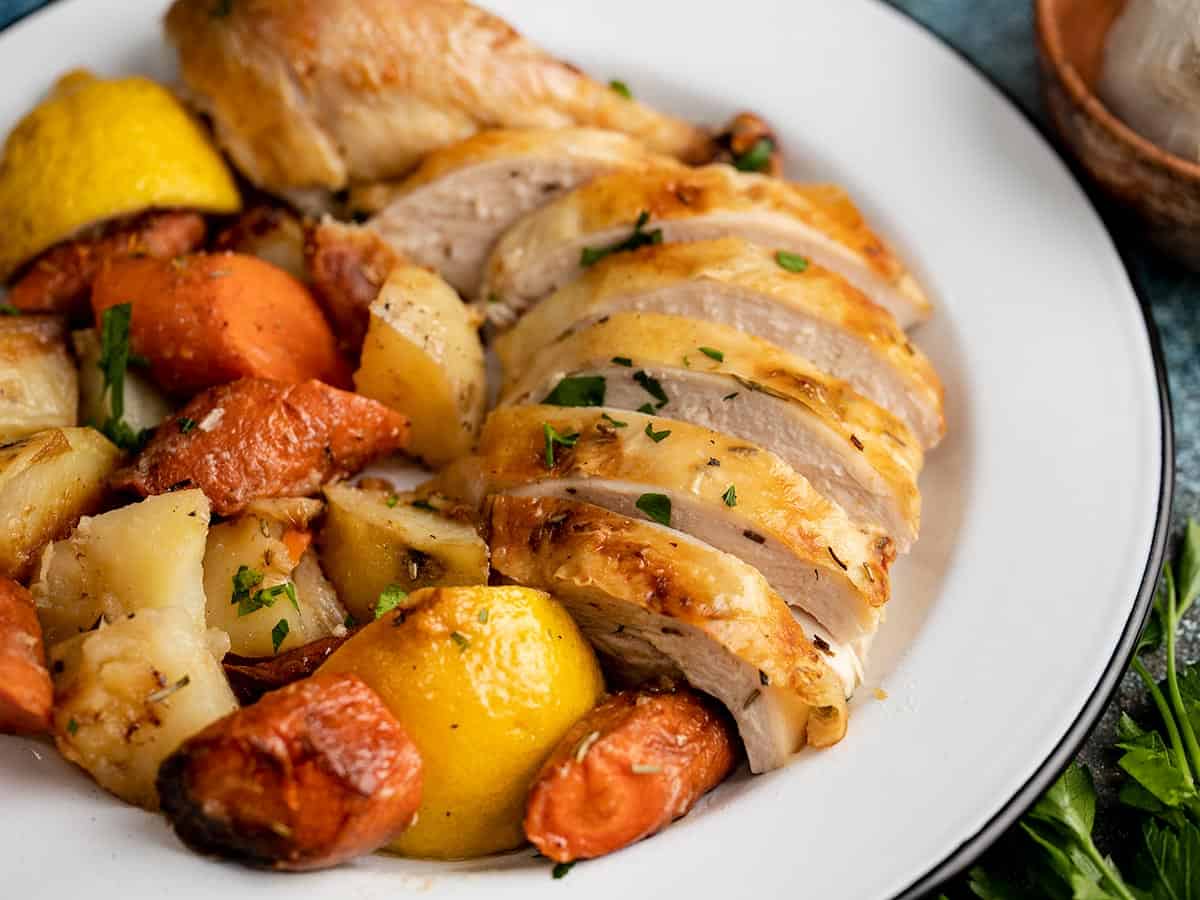
Should I Baste Chicken?
I know, I know. Every time you see someone cooking chicken on a TV show or commercial, there’s always a scene where they have the oven door wide open as they gingerly baste their chicken in its juices. Don’t believe the hype. (Said in my best Flavor Flav.) You don’t have to baste chicken to get juicy results. That’s what the dry brine was for—leaving the oven door open to baste lets all of the heat escape and ruins the roast.
How To Roast A Chicken Without A Roasting Pan
A roasting pan with a rack is ideal because you want enough space between the vegetables and the chicken for air to circulate around the chicken, to crisp it and cook it evenly. If you don’t own a roasting pan, you have loads of other choices. Use a cast iron skillet and nestle the bird on top of the veg. The skin on the back won’t be crispy, but it will still be delicious. In fact, you can roast in almost any low-walled oven-safe dish. For example, use a pie pan or a brownie tin. All that matters is that the sides of the pan don’t block the sides of the chicken. They need to be exposed to develop color and get crispy.
Don’t Waste The Drippings
You’ve now set the foundation for a perfectly roasted bird. But why stop there? As that chicken roasts and that butter melts, all of the drippings fall to the bottom of the pan. This is precisely why you fill the pan with carrots, onions, and potatoes. They soak up all that incredible juice and transform into intensely flavored, unctious bites.
That’s it! With those simple tricks, you will have created intensely flavorful bites with perfectly crispy skin every time. And you can keep enjoying that chicken for days. Pull any leftover meat and use it in casseroles, burritos, or soups. Simmer the bones and create chicken stock. Or eat it cold out of the container as you cry uncontrollably while watching the last episode of From Scratch on Netflix. (Have you seen it?!?!?! We. Must. Discuss.)
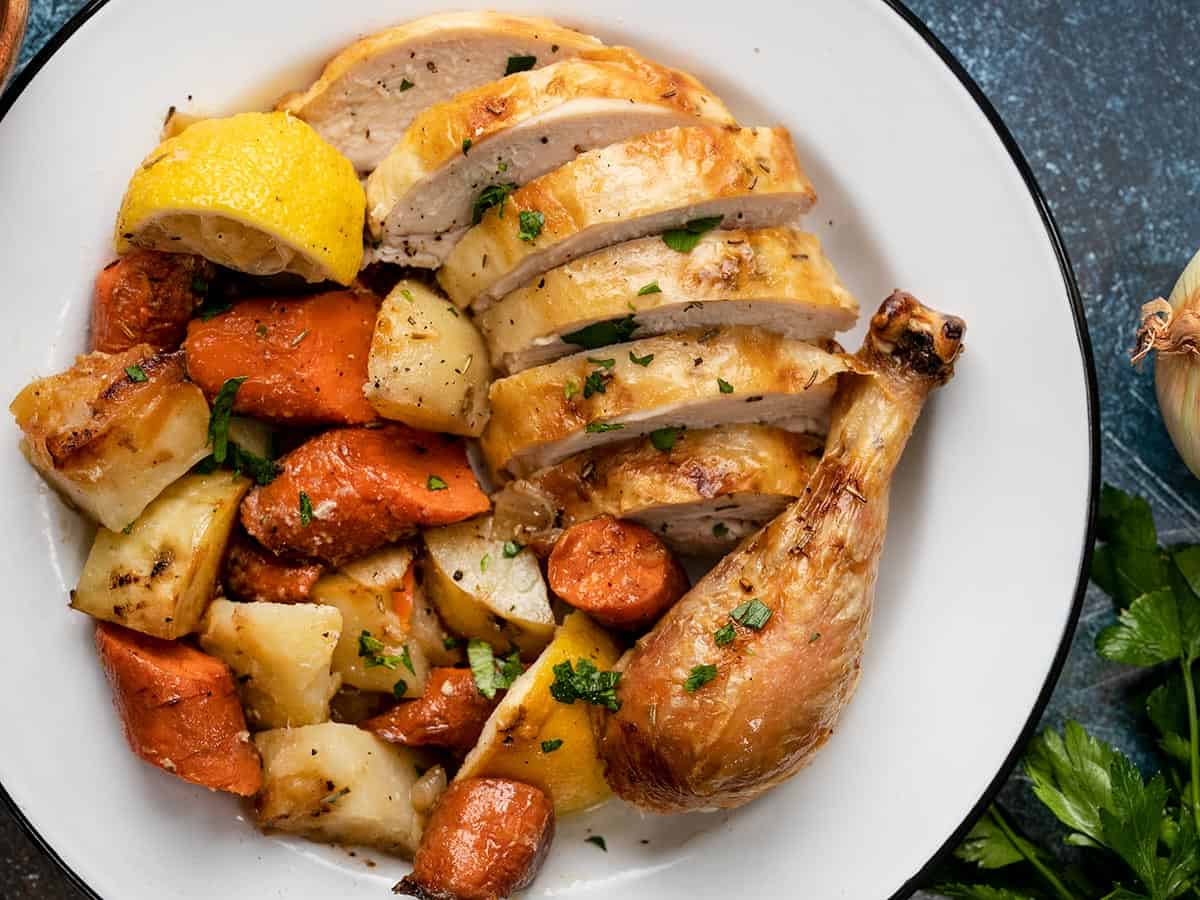
Roasted Chicken
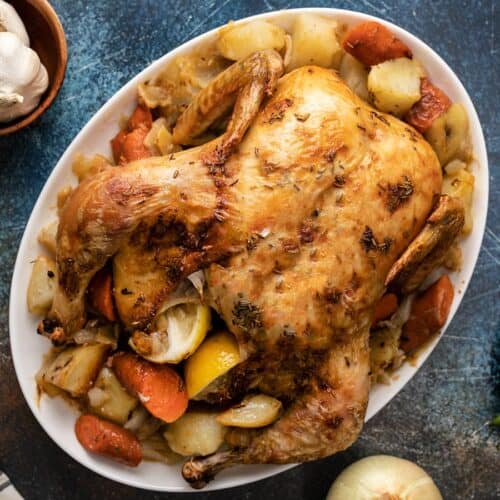
Ingredients
- 1 whole chicken, 5 lbs ($6.62)
- 5 tsp kosher salt or coarse sea salt ($0.20)
- 8 Tbsp salted butter, softened ($1.20)
- 1 Tbsp dry rosemary ($0.30)
- 2 russet potatoes ($0.98)
- 1 onion ($0.49)
- 3 carrots ($0.75)
- 1 lemon ($0.51)
- 1 head of garlic ($0.40)
Instructions
- Place a rack in the center of your oven and preheat it to 425°F. Remove the chicken from its packaging.
- Remove the innards.
- Dry the chicken thoroughly inside and out with paper towels.
- Dry brine the chicken by rubbing salt on it, inside and out. Use 1 teaspoon of kosher salt or coarse sea salt per pound of meat. Or 1/2 teaspoon of fine sea salt or iodized salt per pound of meat. Let it rest uncovered in your fridge for at least an hour but preferably overnight.
- Chop the vegetables. Quarter an onion, slice the carrots, and quarter the potatoes. Add them to a roasting pan.
- Add the dried rosemary to the softened butter and mix thoroughly.
- Place the chicken on a rack over the vegetables and pat it dry again. Cover the chicken inside and out with butter. Work your way under the skin on the breast and add butter there too.
- Quarter a lemon and slice through the top of a bulb of garlic.
- Add the garlic and the lemon into the cavity of the chicken.
- Roast your chicken at 425°F for about 20 minutes per pound, or until a meat thermometer inserted into the breast reads 160°F and inserted into the thigh it reads 170°F. Remove the chicken from the pan and place it on a serving platter. Let it rest for at least ten minutes before carving it.
- Stir the vegetables in the bottom of the pan to cover them with the chicken jus. Serve with slices of roasted chicken.
- Pull any leftover meat off the bones and store it in an air-tight container. Reserve the bones for chicken stock. Simply add them to a freezer-safe container and freeze them until you are ready to use them. Use the pulled chicken for other recipes.
See how we calculate recipe costs here.
Equipment
- Meat Thermometer
Nutrition

How to Roast a Chicken – Step by Step Photos
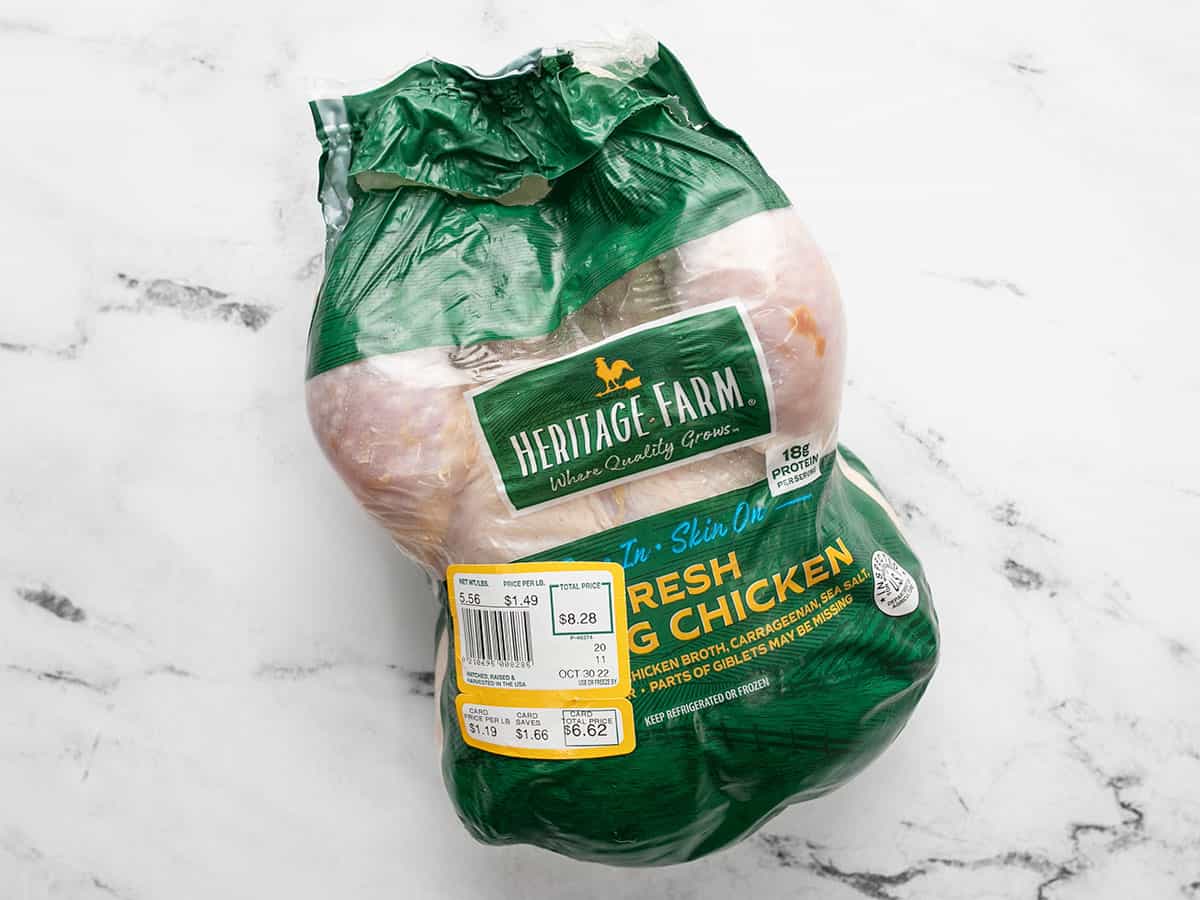
Place a rack in the center of your oven and preheat it to 425°F. Remove the chicken from its packaging.
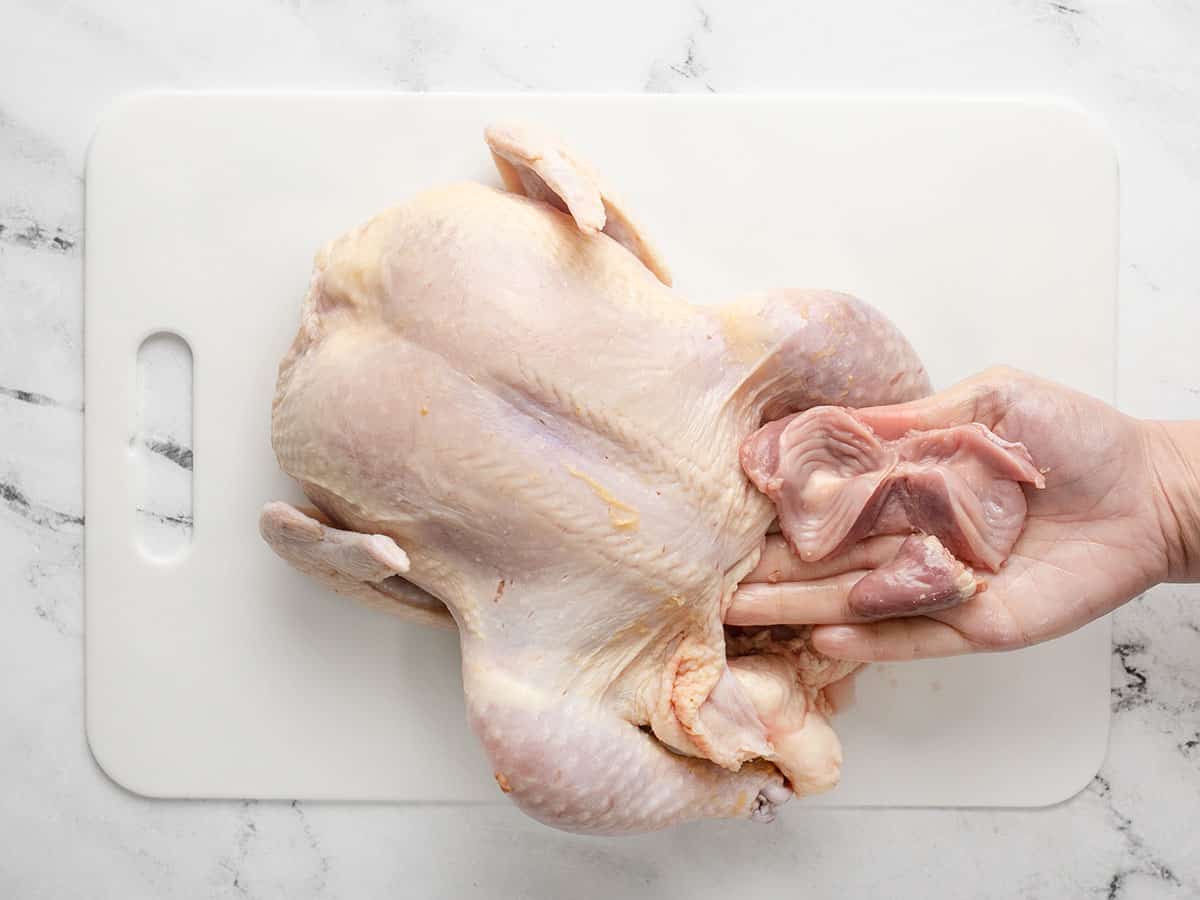
Remove the innards. Reserve them for chicken stock.
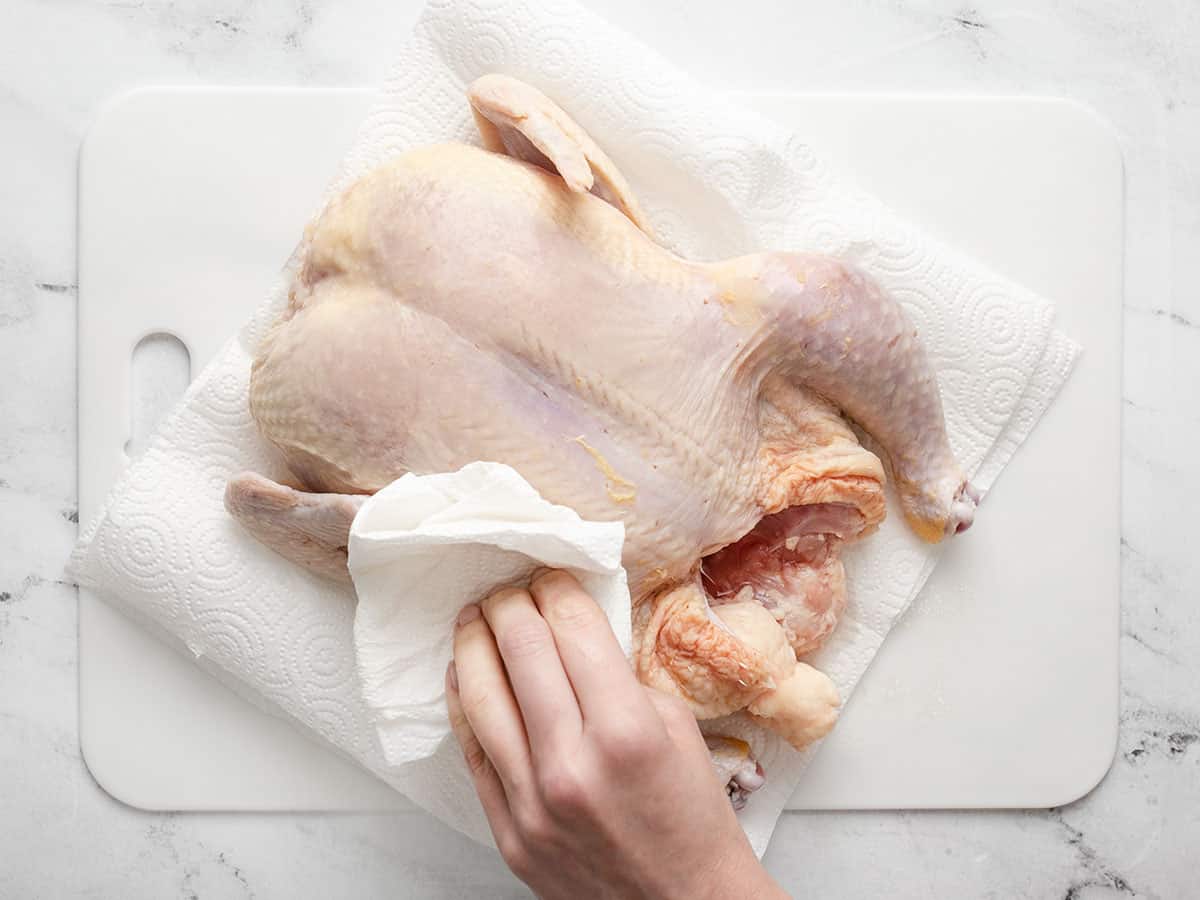
Dry the chicken thoroughly inside and out with paper towels.
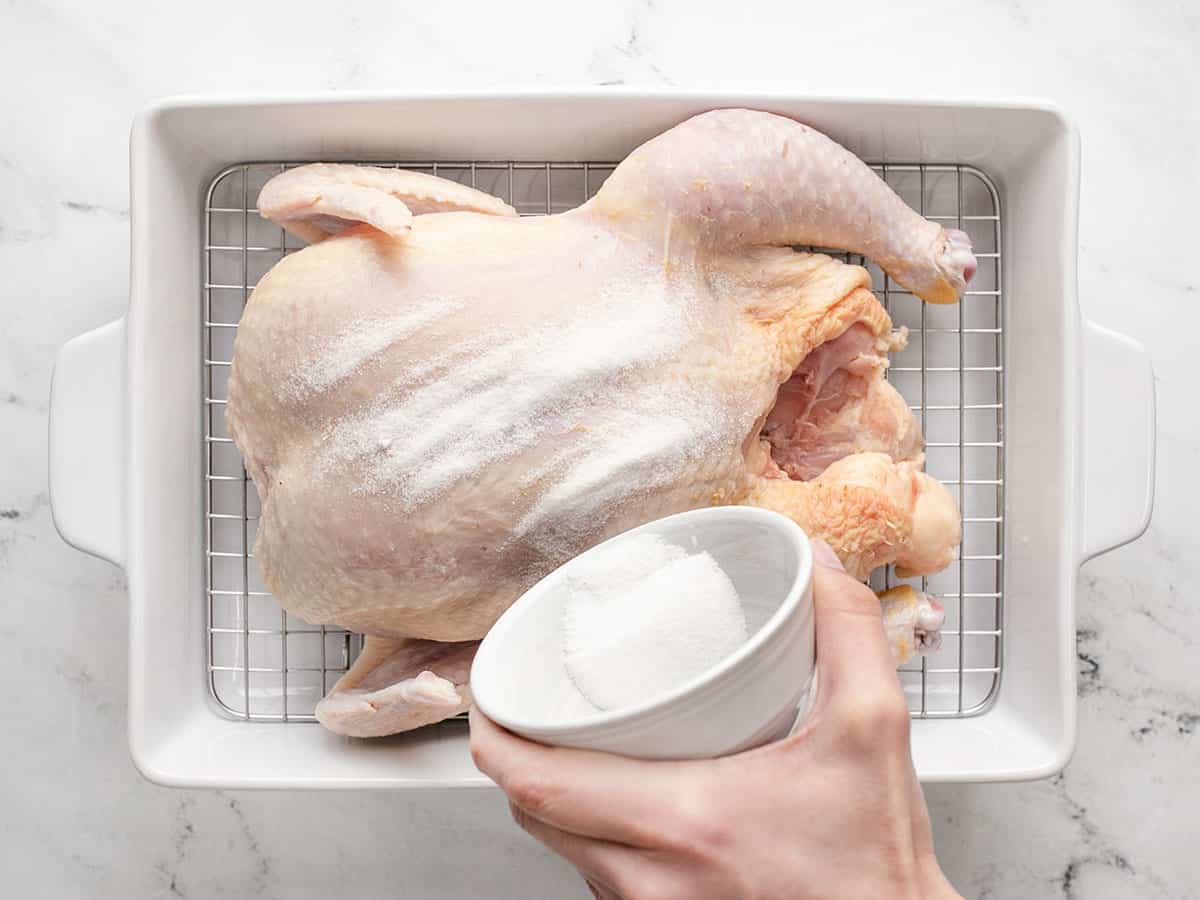
Dry brine the chicken by rubbing salt on it, inside and out. Use 1 teaspoon of kosher salt or coarse sea salt per pound of meat. Or 1/2 teaspoon of fine sea salt or iodized salt per pound of meat. Let it rest uncovered in your fridge for at least an hour but preferably overnight.
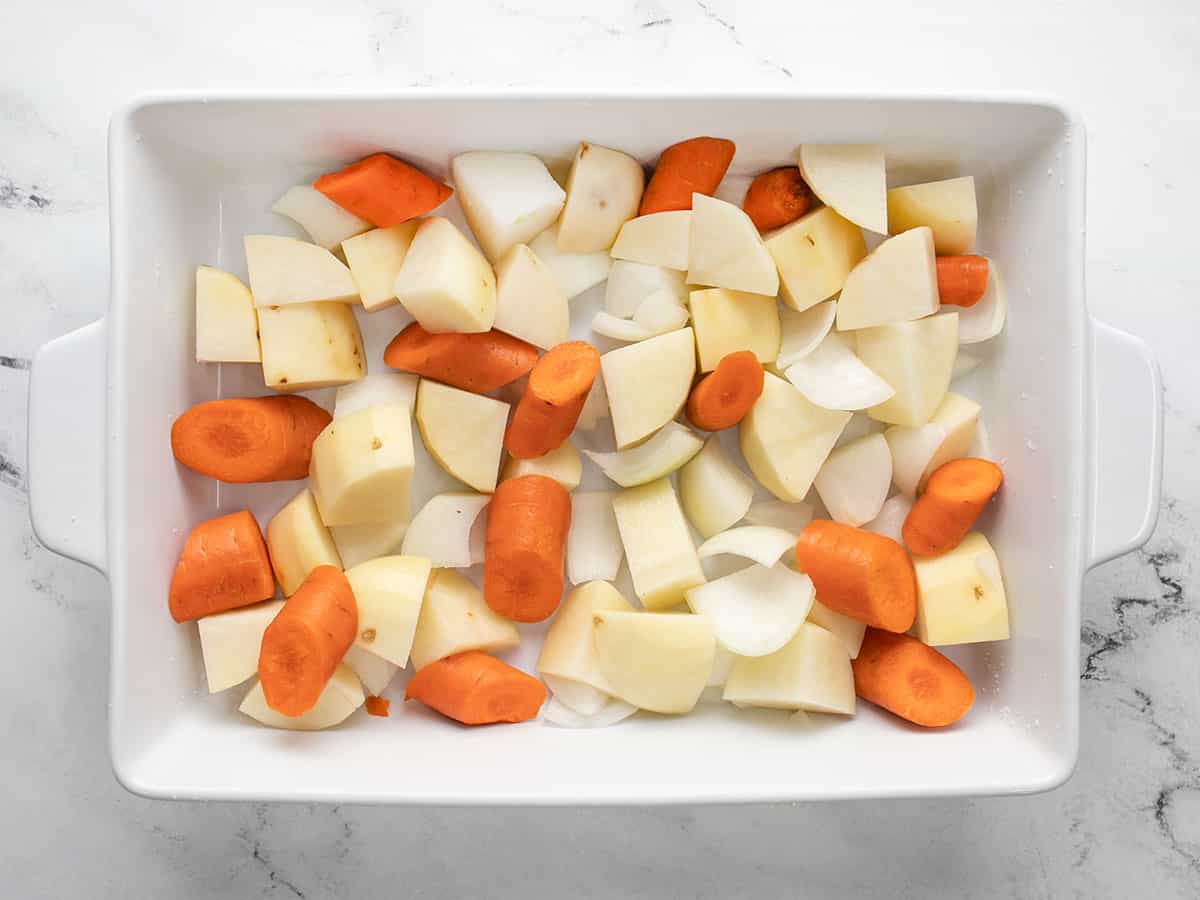
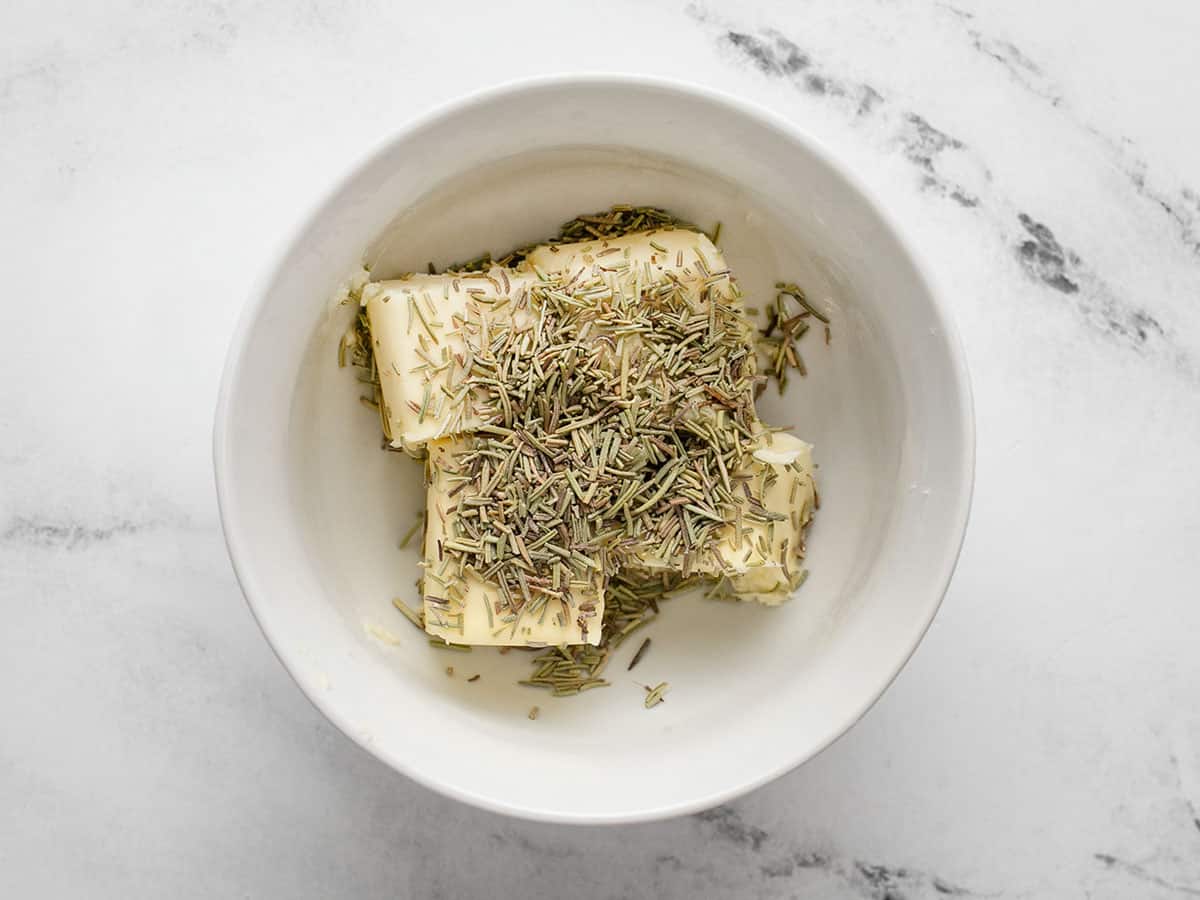
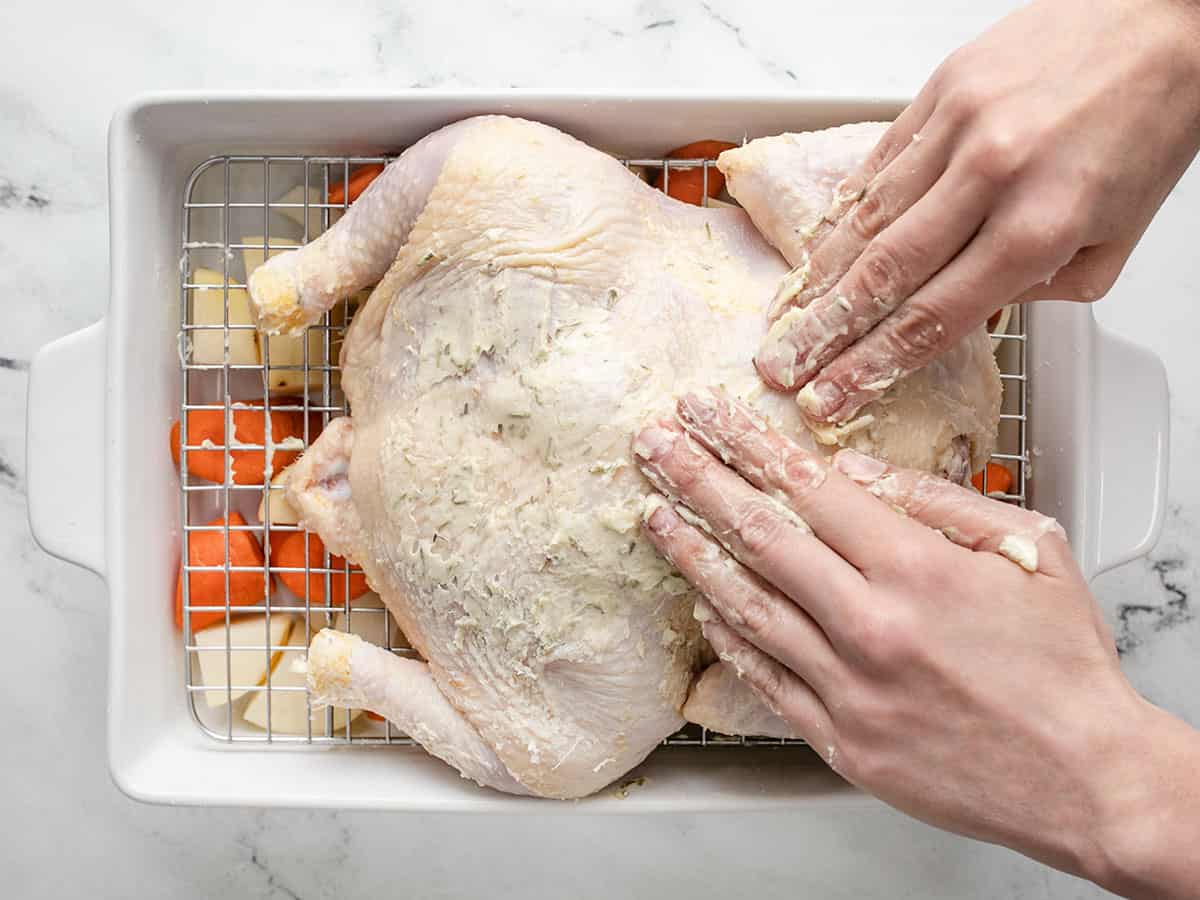
Place the chicken on a rack over the vegetables and pat it dry again. Cover the chicken inside and out with butter. Work your way under the skin on the breast and add butter there too.
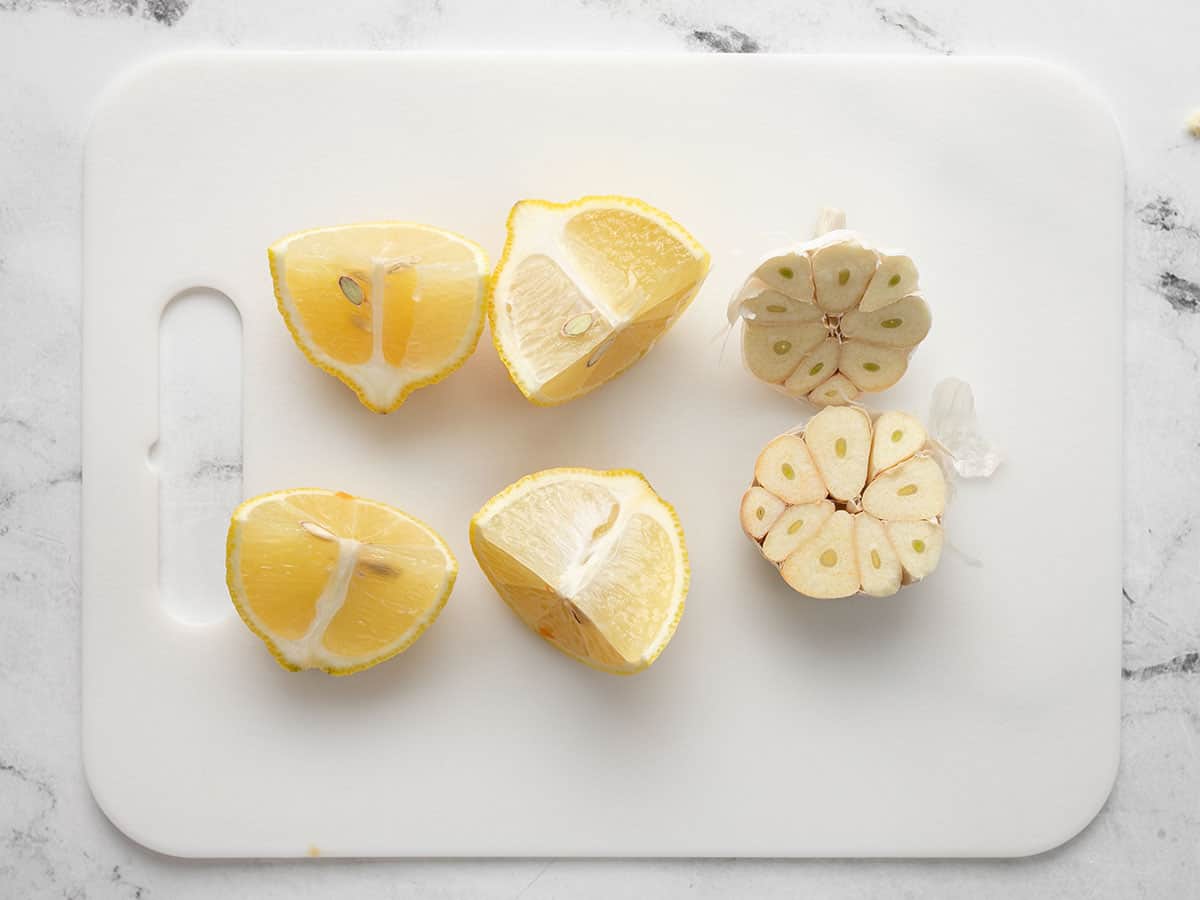
Quarter a lemon and slice through the equator (the midpoint between the tip and the root) of a bulb of garlic.
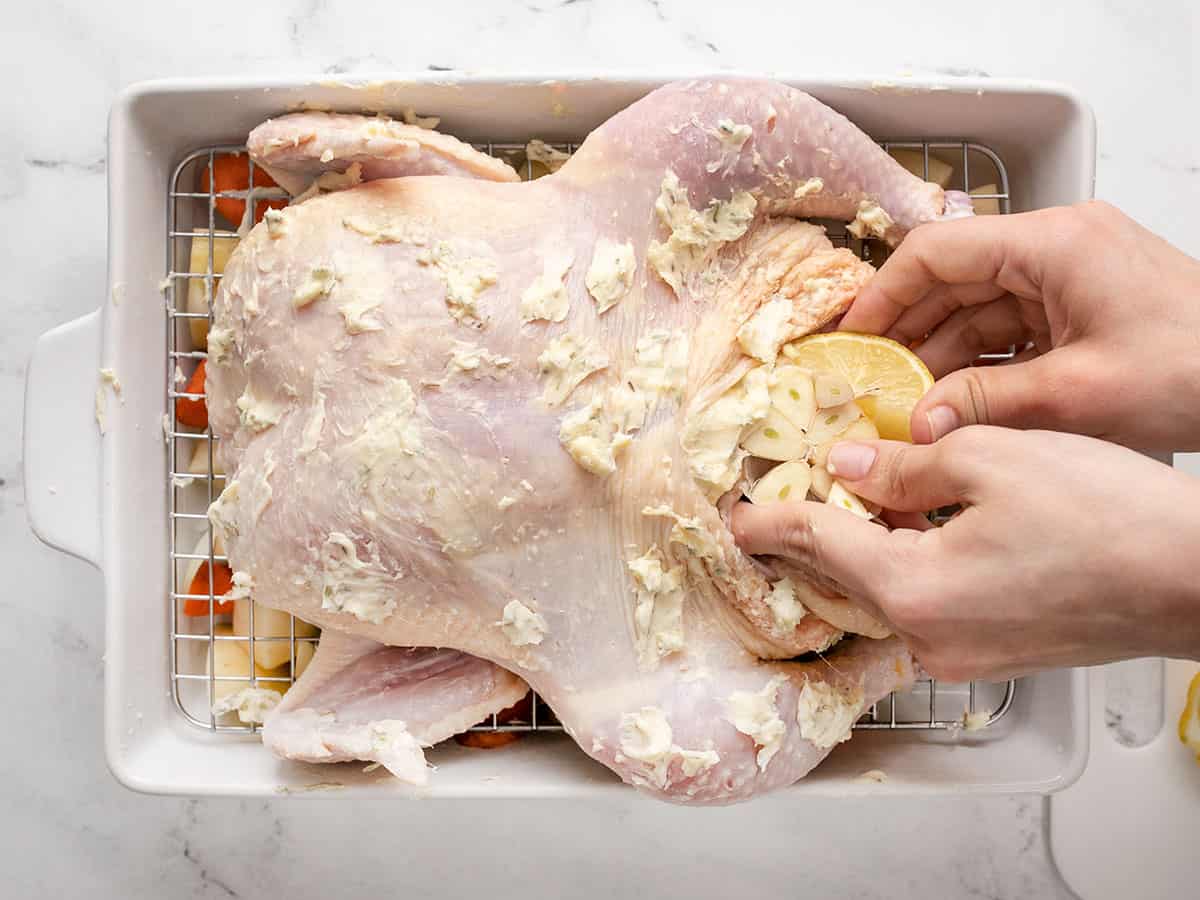

Add the garlic and the lemon into the cavity of the chicken.
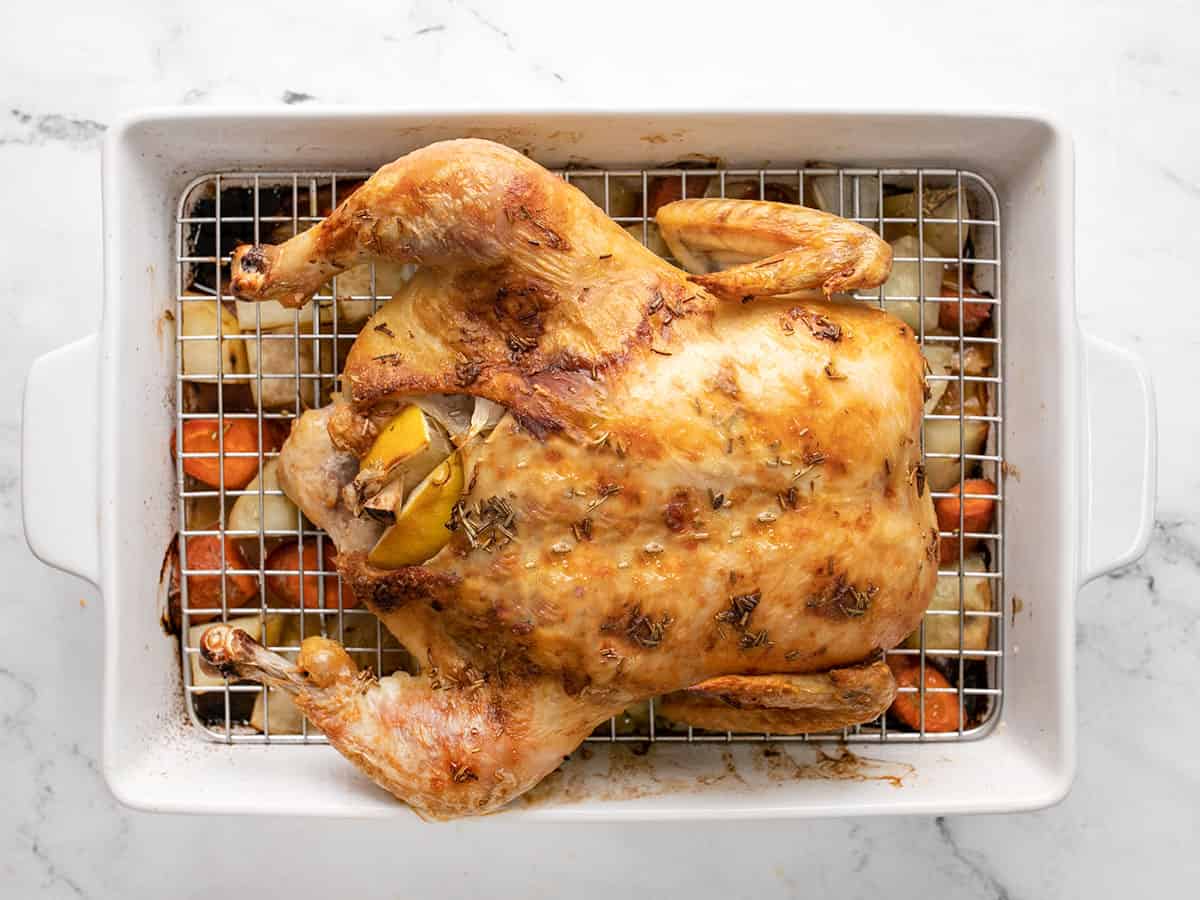
Roast your chicken at 425°F until a meat thermometer inserted into the breast reads 160°F and inserted into the thigh it reads 170°F. Remove the chicken from the pan and place it on a serving platter. Let it rest for at least ten minutes before carving it.
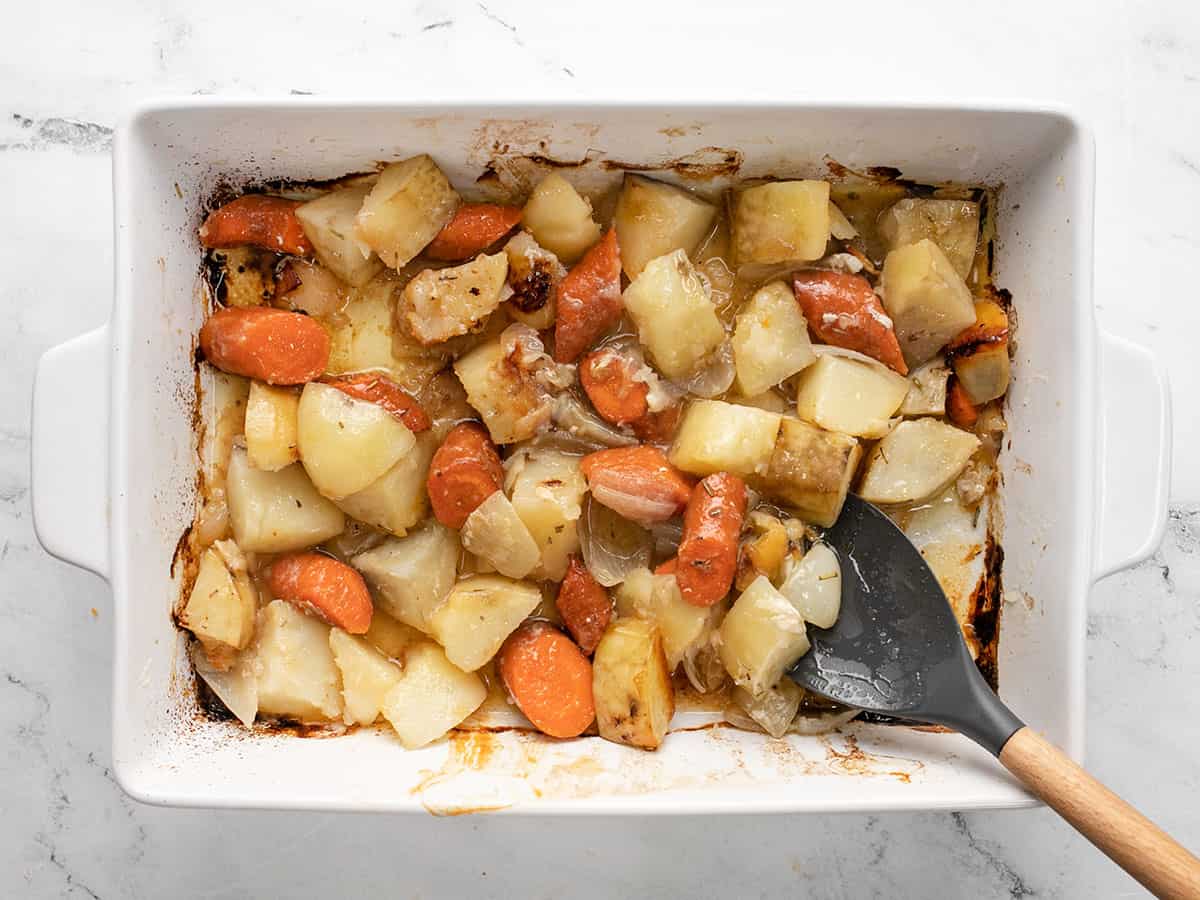
Stir the vegetables in the bottom of the pan to cover them with the chicken jus.
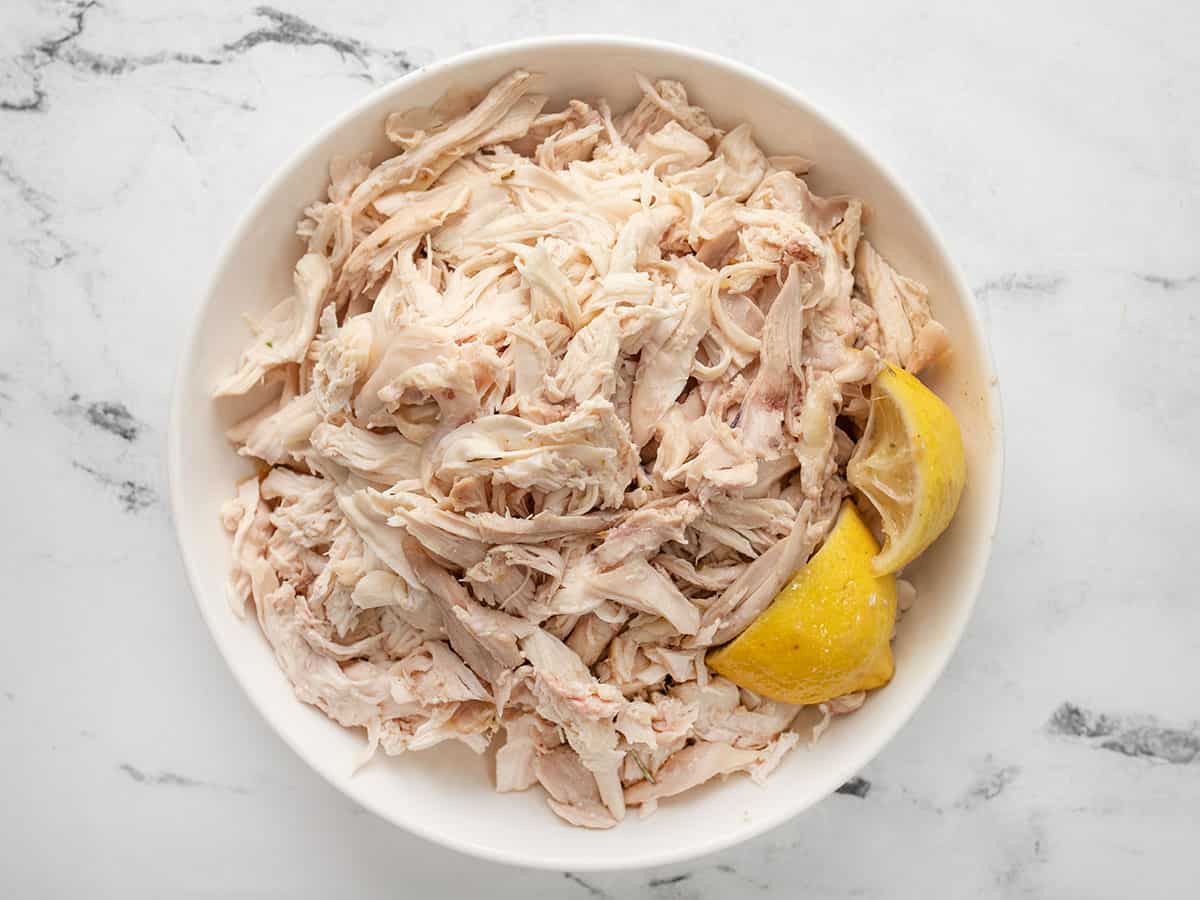
Pull any leftover meat off the bones and store it in an air-tight container. Reserve the bones for chicken stock. Simply add them to a freezer-safe container and freeze them until you are ready to use them. Use the pulled chicken for other recipes.
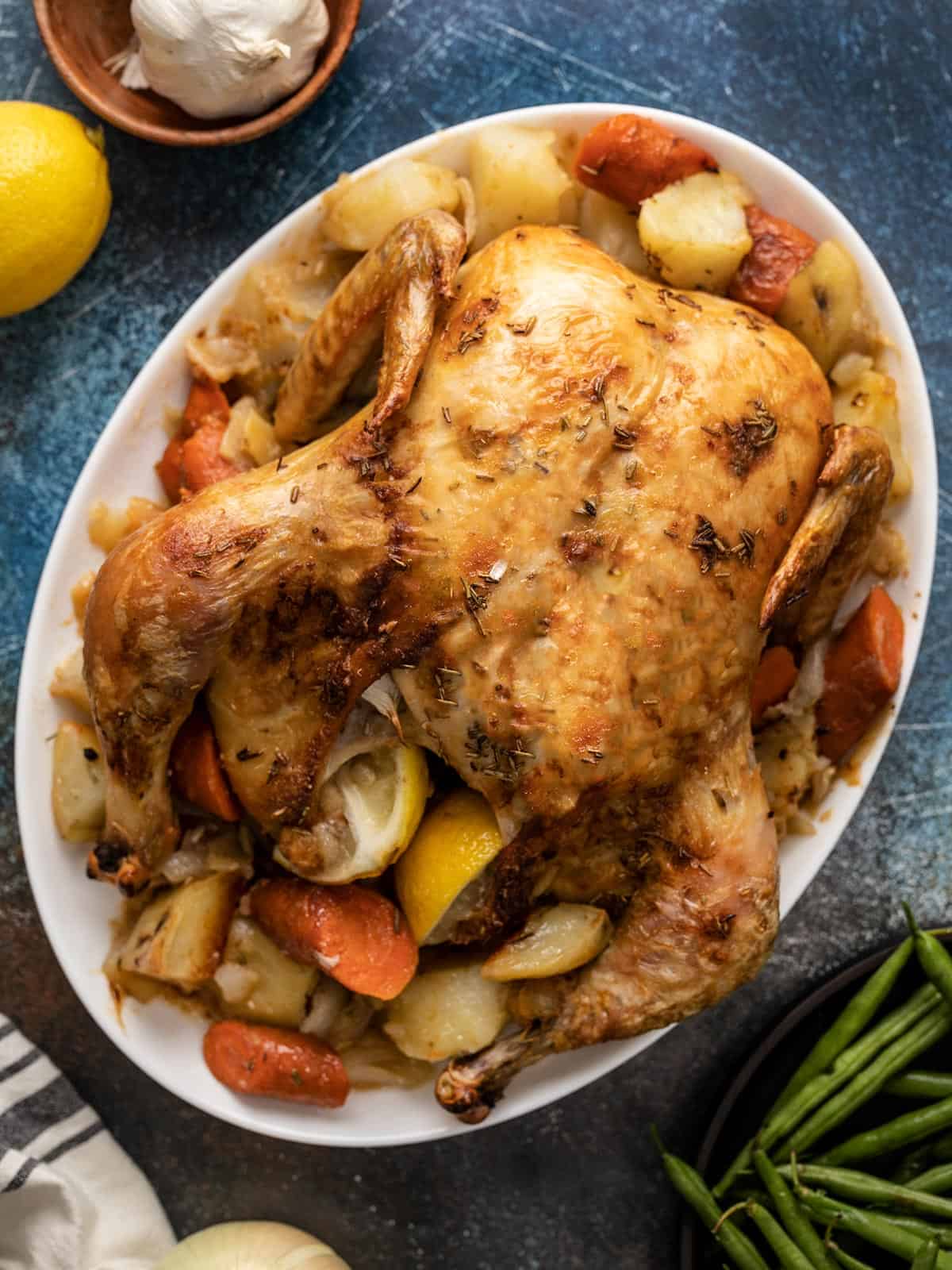


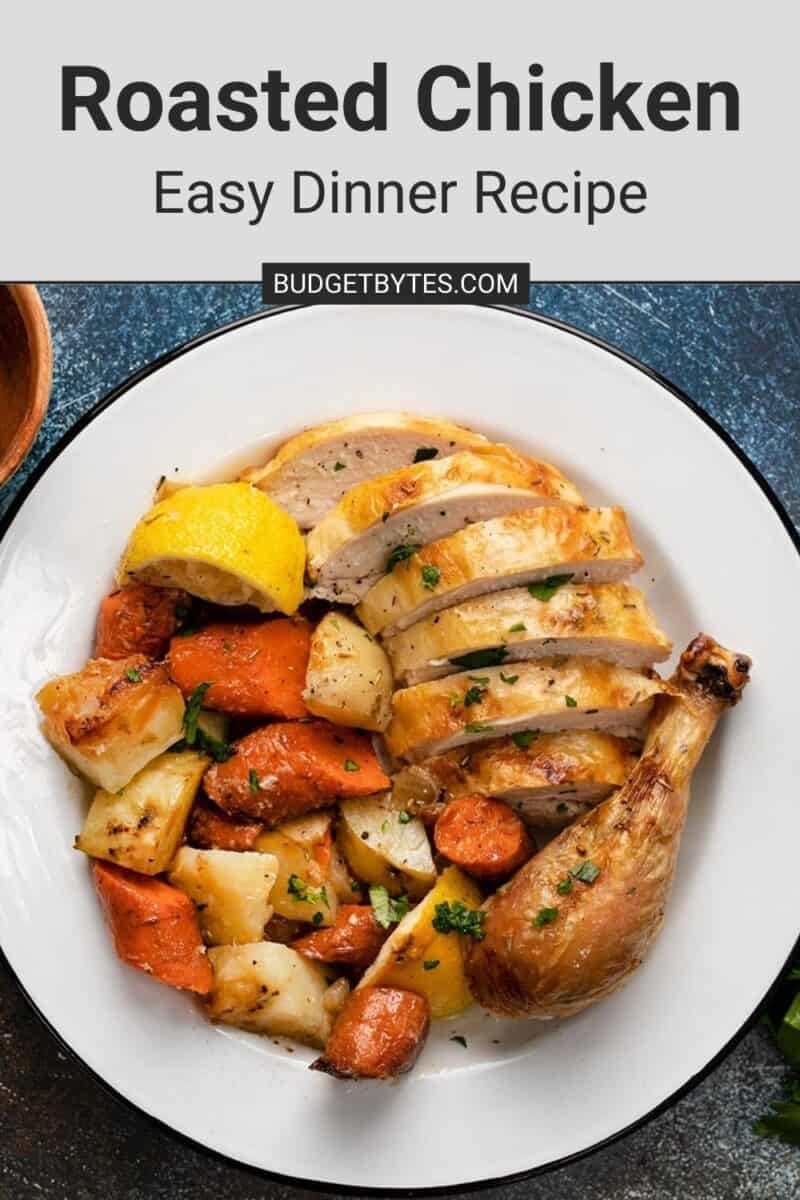
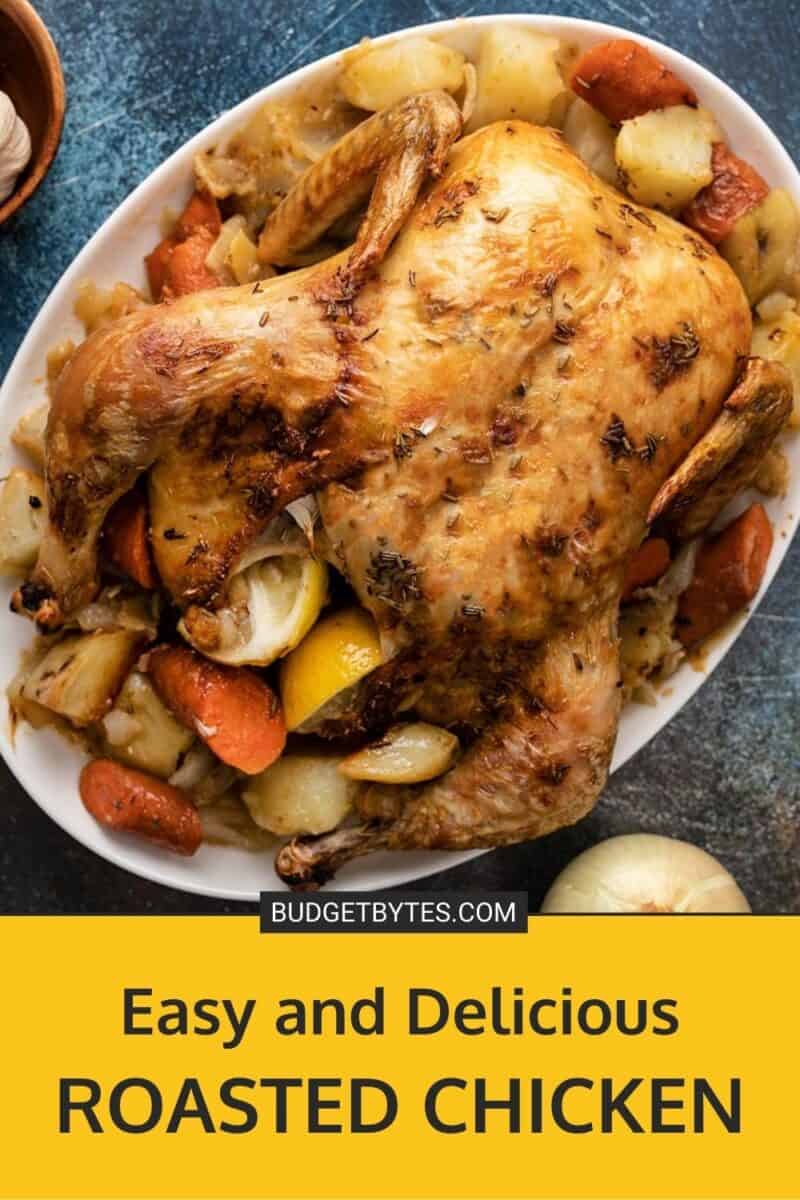
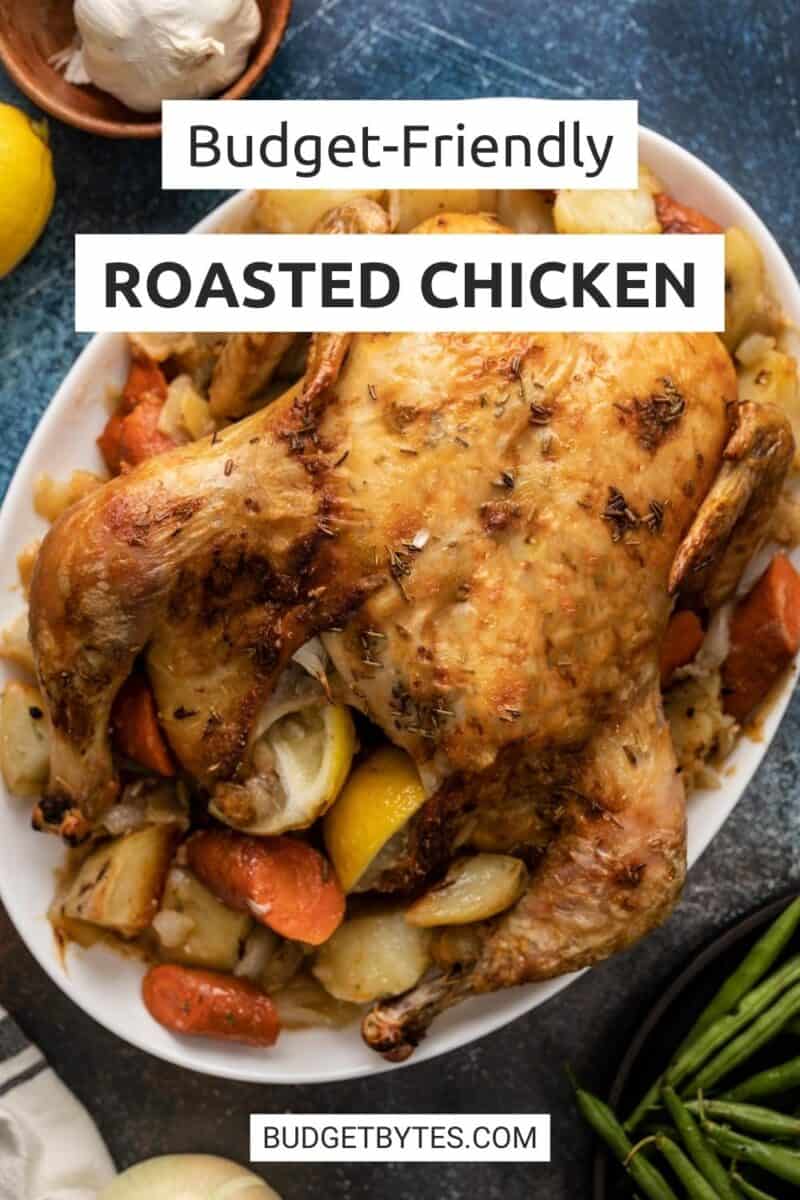
Another absolutely stellar recipe!
Unfortunately, my supermarket only had two whole chickens left to buy, and they were each around $20 (no thank you!). Luckily, I was able to grab a value pack of three large bone-in breasts, with the skin on, for half as much.
This recipe is so simple to put together that, despite the swap, I was able to use almost the exact same method and cook time. I stuck some lemon slices and garlic cloves under the skin since there was no cavity, and used less butter, but those were really the only changes I needed.
No exaggeration, this is the best chicken I have ever made. The skin was beautifully crispy, the flavor from the brine went all the way down to the bone, and the potatoes and carrots were perfectly cooked. I can’t get over how decadent it tasted for having relatively few steps and ingredients. I served this with a simple salad with vinaigrette, and I think it will be my go-to “cook to impress” recipe.
Made this tonight for myself and my mother – I don’t think I’ve seen her eat so enthusiastically in years. It felt really good to see something I made being devoured by the pickiest eater in TX. 💜
I did follow Chloe’s advice in a previous comment and used less butter – I used about 4 tablespoons, which seemed to work well enough. Like I said, my mother is a fussy eater, and I didn’t want to take any chances by loading everything with butter. It was risky enough for me to stuff the cavity with lemon and garlic. 😂
My chicken (5.15lbs) turned out great, though I probably could have taken it out earlier – final temp was higher than I expected. If it matters, I did roast it in a 10×15 glass baking dish, and only had enough time to do a 1hr dry brine.
The vegetables were the star of the show though; absolutely delicious. I did the same thing as Kelsey, and waited to add them in later: I put them in after 40 minutes.
This was my first time roasting a chicken, so thanks again for making these recipes so forgiving and accessible to new home cooks! 💜
I’m confused as well – if the cooking time is 20min per pound, and the recipe calls for a 5lb chicken, why is the listed cooking time 1hr instead of 1hr 40min?
You’re right, Megan! the math isn’t mathing there! It should still be 20 minutes per pound, but that should equal to 1 hr and 40 minutes. I’ll get that changed!
Thanks so much Paige, I was worried I was missing something obvious that everyone else had managed to figure out. 😅
Going to make this tonight, wish me luck!
I only have a toaster-oven to cook with, so if I was to spatchcock my chicken, where should I put the lemon and garlic? Just laying them underneath the bird maybe?
That would be my best guess, but it’s hard to say what the best method would be for sure without testing!
How many minutes per pound should the chicken roast approximately? I understand to check the temp.
Sorry for the confusion, it will be approximately 20 minutes per pound.
I accidentally got an 8lb chicken for this recipe. Do you have any advice on modifying the cooking time? I’m concerned cooking it at 425 the whole time would make the outside too dry/burnt by the time the inside got up to the right temperature.
An 8 lb chicken is quite a score! You have two options:
1. You can spatchcock the chicken. You would cut out it’s spine, place it flat and breast up on a sheet pan, and press down on the breast to flatten the bird. You can cook it at 400°F.
2. Lower the heat to 350°F and roast it 20 minutes per pound plus an additional 10 to 15 minutes, or until the temperature of the bird reaches 160°F.
Have fun and happy cooking!
I’ve made this twice now, both times doing an overnight dry brine. Just the juiciest result ever! The first time I used salted butter and I thought it came out too salty for my taste, used unsalted butter the second time around and got rave reviews from all. A very easy, impressive dinner!
Have made this recipe multiple times with a 4 or 5 pound chicken and I love it so much. The meat comes out moist, the skin crispy. I make extra potatoes and carrots underneath and my partner described them as the best vegetables he has had (he doesn’t really like vegetables).
It was a decent recipe for the first time, I’m only giving 3 stars because the recipe calls for way too much butter for a 5 lb chicken. Against my better instincts I ended up rubbing on the full amount of butter both on top of the skin and underneath and it was swimming in butter. I typically like to follow the original recipe as is at first and then tweak to my liking afterward. But this I will say you can safely cut out at least 2 tablespoons of the butter that this recipe calls for and you will be more than fine for a 5lb chicken. Not only was the chicken super buttery but so were the vegetables. Everything pretty much tasted like butter. I think if you cut back on the butter you can salvage much of the recipe. Next time I would also add thyme and additional seasonings other than just rosemary, salt, and butter to elevate this a bit more. Also, I didn’t use salted butter because the brine was already a lot of salt and I didn’t want to add more salt to a bird already brined in salt. Overall the recipe is an ok base if it’s your first time roasting a chicken, my main issues were too much butter and slightly bland with just the rosemary on top.
I haven’t cooked a whole chicken in years. I cooked 2 tonight, in a large roasting pan, using this recipe. Planning to shred the extra chicken to use in nachos & quesadillas later this week. I made gravy with chicken stock & drippings, and will use both carcasses to make more stock. This whole thing is just awesome. And dirt cheap, considering I got my chickens at half price!
Absolutely loving this blog lately. So glad I found you! Thanks for all the fine work! 😊
I’ve baked chicken many times but this was the best ever.
Holy Moly- this chicken is delicious! My husband said several times while eating that it was the best chicken he’s ever had 😊
I used a Bluetooth meat thermometer and it took 1h40 minutes, or so. I waited and added the veggies for the last 40ish minutes so they didn’t char. Next time I’ll double the veggies since my roasting pan had lots more room and they were delicious too.
I didn’t remove any salt, although the second drying did remove some. Some skin bites seemed quite salty, but it all balanced out if you had meat +skin and made it so yummy.
Great recipe!!
Thank you! XOXO -Monti
Will try this chicken today.
Hi. Thank you so much for the recipe. Of I don’t have dried rosemary, do you think that dried Italian seasoning would work? Thank you!
Absolutely! Thank you for trying it! XOXO -Monti
This always confuses me – when you dry brine the chicken does the salt go on top of the skin, or do you slide it between the skin and the meat?
LEGIT question. You can rub it just on top of the skin. It will penetrate and help alter the proteins of the skin, so it crisps up nicely. If you want to totally nerd out (obvi, I am a massive food nerd), try rubbing fresh chopped rosemary and lemon zest into the salt and THEN rubbing it on the chicken. BEYOND. XOXO -Monti
I noticed the chicken had been injected with chicken broth, carageean, and sea salt, then the outside is rubbed with salt overnight…I tend to not add extra salt to poultry that’s been injected (including my Thanksgiving Turkey). Was the meat quite salty?
The meat was perfect. Dry brining seems crazy at first. I know I was dubious the first time I tried it. It really is the most amazing technique. I hope you try it. XOXO -Monti